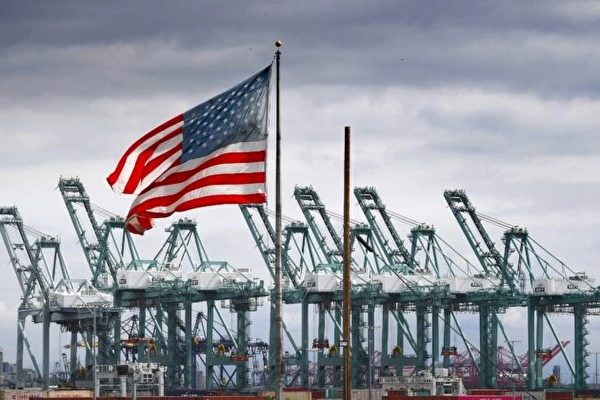Shanghai Zhenhua Heavy Industries (Group) Co., Ltd. (referred to as ZPMC) is the world’s largest crane manufacturer. Its assembly plant is located at the vast Changxing Base at the mouth of the Yangtze River in Shanghai. This huge production base has ample space to manufacture and assemble container cranes commonly seen in ports around the world. Typically, these cranes are assembled and shipped out. ZPMC has large docks where cranes are loaded onto specially designed heavy ships and transported to various parts of the world.
ZPMC’s factory sits adjacent to a crucial Chinese facility – the Jiangnan Shipyard, the flagship shipyard of the increasingly expanding People’s Liberation Army Navy (PLAN). Currently, the PLAN’s aircraft carrier “Fujian” of the Type 003 is undergoing sea trials, while the first Type 004 nuclear-powered aircraft carrier is under construction.
The container cranes produced by ZPMC account for 80% of the container handling equipment in the United States, crucial for the operations in American ports. These cranes are highly efficient, equipped with internet connectivity to ensure they can fully collect and share multiple data streams, including surveillance camera systems monitoring all activities inside and around the crane. Internet connectivity means that these cranes are not just cranes but also terminals on the global network using Internet Protocol (IP).
Configuring IP can be both beneficial and detrimental. The U.S. government has ordered the removal of Hikvision closed-circuit television cameras because of concerns that this widely used CCTV system has pervasive presence within the U.S. government and is being used to monitor sensitive government facilities. Following the same directive, equipment from Huawei and ZTE, among others, has also been dismantled.
The Federal Emergency Management Agency (FEMA) is tasked with supporting the continuity of operations (COOP) sites for the U.S. government and is assisting state and local government agencies in “removing and replacing” Hikvision surveillance equipment from their emergency operation centers (EOCs).
The cranes manufactured by ZPMC are equipped with similar cameras and complex sensors – Chinese analysts can use them to track goods, send signals to the cranes, potentially rendering them unsafe or inoperable.
In February 2024, the Biden administration announced plans to provide $20 billion to ports for dismantling ZPMC cranes and replacing them with cranes produced by PACECO, a subsidiary of Japan’s Mitsui E&S Holdings.
The “removal and replacement” of port cranes is a larger, more complex civil engineering project compared to the restoration of CCTV systems in U.S. government facilities, COOP sites, and EOCs.
To achieve this, meticulous planning and scheduling are essential to ensure that commercial throughput in U.S. ports remains uninterrupted and that there are no disruptions due to international events such as tensions in the Western Pacific region.
The Biden administration’s executive order addresses long-standing port security issues that have been overlooked due to gaps between the roles and responsibilities of agencies like the U.S. Coast Guard, the Department of Homeland Security (DHS), other departments, the Department of Defense, and the Department of Justice.
The executive order grants the Coast Guard “clear authority to address malicious cyber activities in the Maritime Transportation System (MTS), requiring vessels and waterfront facilities to address network conditions that could endanger vessel, facility, or port safety.”
Simultaneously, the government issued the U.S. Maritime Advisory “2024-002-Global Foreign Adversarial Technology, Physical, and Cyber Impacts.” This unusual advisory details several network security issues in civil maritime environments. The Chinese National Logistics Platform (LOGINK) software widely used in maritime logistics tracing has been confirmed as untrustworthy software originating from China and potentially used for malicious purposes. Nuctech, a company producing widely used advanced detection equipment in ports, is also listed as a company of concern. Removing untrusted Chinese equipment from sensitive ports and operational activities is not baseless.
In May 2023, Microsoft first reported Chinese cyber attacks on critical U.S. infrastructure, with the “Voltage Typhoon Operation” seeking the ability to disrupt essential communication infrastructure between the United States and Asia in future crises.
The U.S. Cybersecurity and Infrastructure Security Agency (CISA) issued initial opinions and entered a period of calm – likely due to the U.S. government convening working groups for research, assessment, and recommendations.
Starting from December 2023, public comments by CISA Director Jen Easterly, FBI Director Christopher Wray, and the newly appointed National Security Agency Director and Cyber Command Commander General Timothy Haugh began revealing the analysis results during this period, with officials appearing in Congress multiple times, sharing these findings openly and unequivocally.
General Haugh stated that China was ensuring access to critical U.S. networks before direct confrontation between the two countries.
Mr. Wray further clarified: “It’s difficult to know the intent of these preparatory activities, but it aligns with China’s broad goal to hinder U.S. efforts to defend Taiwan.”
Ms. Easterly said: This is essentially a “ubiquitous, one-hit” scenario. The Chinese government believes they are likely to break U.S. will to defend Taiwan in a major conflict.
Eliminating Chinese “spy cranes” and fortifying U.S. port facilities prompt China to enhance the “Voltage Typhoon” operation, ensuring various means of attacking critical U.S. infrastructure in all possible ways.
The article was published in the English edition of Epoch Times.
The views expressed in this article are solely those of the author, and do not necessarily reflect the views of the Epoch Times.

